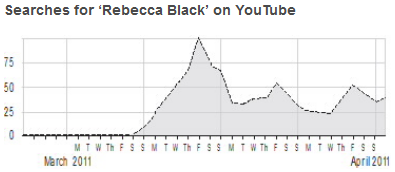This is a guest post from Jonah Berger, Marketing professor at the Wharton School at the University of Pennsylvania and New York Times bestselling author of “Contagious: Why Things Catch On.” See the original post this is adapted from and more like it on his blog.
There’s a science behind word of mouth and why things go viral.
A few years ago, teenager Rebecca Black became an internet sensation with her mega-hit “Friday.” The song collected over 300 million views and became the most viral video of 2011. It made Ms. Black a millionaire many times over. There was only one hitch: Everyone hated the song.
Rebecca’s mom had paid record label ARK Music Factory $4,000 to put a song together for her daughter. The result was a somewhat over-produced number about getting up in the morning, going to school, and dealing with big teenage dilemmas like whether to sit in the front seat or the back seat of your friend’s car.
All in all, not the most amazing tune. Indeed, some critics called Friday “the worst song ever” (which, if you really think about it, is actually quite an accomplishment).
But, if people didn’t like the song, why was it so popular? Why did millions of people watch and share the video?
Trends in search data
One clue comes from analyzing search data. If you look at the number of searches for “Rebecca Black” on YouTube over time, you’ll notice an interesting pattern. There is a spike in searches and then a decline. Then another spike and a decline. And so on, again and again.

Look closer though, and you’ll notice that the spikes are not random. In fact, they’re exactly seven days apart. And if you look even closer you’ll notice that they’re always on the same day of the week. That day? Friday.
Rebecca’s song is equally bad every day of the week. I’ve checked. It’s bad on Monday, bad on Tuesday, bad on Wednesday, etc. But Friday the day provides a little environmental reminder, or trigger, to make us think about (and share) “Friday” the song.
The same psychology works with all sorts of products and ideas. Think about peanut butter. If someone were to say, “peanut butter and…” what thing comes to mind?
If you’re like most people, you probably said jelly. Seeing, hearing, or even thinking about peanut butter makes its frequent partner, jelly, top-of-mind. Peanut butter is like a little advertisement for jelly.
Triggers have a big impact on human behavior.
Triggers shape the choices we make, the things we talk about, and the products we buy. Playing French music at the grocery store makes people more likely to buy French wine, and playing German music makes people more likely to buy German wine.
Triggers even affect big, consequential choices like how people vote. We found that where people vote (e.g., a church or a school) actually changes how they cast their ballot. Voting at a school led people to support raising taxes to increase school funding. Voting at a church could have similar effects, changing whether people support gay marriage or stem cell research.
But the best part about triggers? Anyone can apply this concept. By linking your product or idea to prevalent triggers you can help your own initiatives succeed. In my own work, I’ve used it to help companies like Boston Market increase word of mouth by over 20%.
Word of mouth isn’t restricted to hidden bars and crazy viral videos.
If you understand why people talk and share, you can get the word out about any product or idea. From BtoC to BtoB. From recycling initiatives and logistics management software to political causes and new products.
Generating word of mouth or getting something to go viral sometimes seems like magic. Like catching lightning in a bottle. But it’s not. By understanding the science behind social influence you can make your own products and ideas contagious.
About Jonah Berger
Jonah Berger is a Marketing professor at the Wharton School at the University of Pennsylvania, and author of the New York Times bestseller Contagious: Why Things Catch On. He consults from a variety of companies and organizations on how to generate word of mouth and help products, ideas, and behaviors catch on.
- Web |
- More Posts(7)



Trackbacks/Pingbacks
[…] See on wordofmouth.org […]